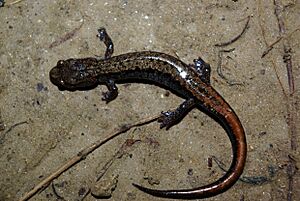Korean crevice salamander facts for kids
Quick facts for kids Korean crevice salamander |
|
|---|---|
 |
|
| Conservation status | |
| Scientific classification | |
| Genus: |
Karsenia
|
| Species: |
koreana
|
The Korean crevice salamander (scientific name: Karsenia koreana) is a special type of lungless salamander. This means it doesn't have lungs to breathe! Instead, it uses its moist skin. You can find this unique creature living under rocks in limestone forests on the Korean peninsula.
An American science teacher named Stephen J. Karsen found this salamander in 2003. He was working in Daejeon, South Korea. Scientists officially described it in 2005.
What makes it extra special? Most salamanders without lungs live in other parts of the world. But the Korean crevice salamander is the very first one found in Asia! It's also the only species in its group, called Karsenia.
Contents
Where Does the Korean Crevice Salamander Come From?
Scientists study the family tree of animals to understand where they come from. They used special tests on the Korean crevice salamander's DNA. These tests showed that it is closely related to salamanders found in North America.
This suggests that lungless salamanders might have lived all over the world a long time ago. This was about 60 to 100 million years ago! As the Earth's climate changed, many of these salamanders in the "Old World" (like Asia) disappeared. But those in the "New World" (like North America) survived and thrived.
This pattern is also seen in other plants and animals. It shows how species can spread across continents over millions of years.
What Does the Korean Crevice Salamander Look Like?
The Korean crevice salamander is a small, sturdy animal. It has a broad head and small eyes that stick out a little.
- Size: Both male and female salamanders are similar in size. They measure about 38.5 to 47.7 millimeters (about 1.5 to 1.9 inches) from their snout to their tail vent.
- Body: They have 14 to 15 grooves along their sides, called costal grooves. These grooves help them move and stay flexible.
- Tail: The tail starts out round. But for some salamanders, it becomes flatter towards the tip. A full, healthy tail is usually about as long as the salamander's body.
- Color: These salamanders are mostly dark in color. They have a wide stripe on their back. This stripe can be reddish-brown, yellowish-brown, tan, or even dark brown. Sometimes it's very bright and easy to see, other times it's harder to spot.
- Sides and Belly: Their sides are dark with tiny, whitish speckles that are hard to see. Their belly is pale with larger white spots. These spots are usually missing right down the middle of their belly.
Where Does the Korean Crevice Salamander Live?
This salamander lives in damp, rocky areas. It prefers slopes and rockslides made of limestone. These areas are usually found in young forests. The forests often have Pinus densiflora (a type of pine tree) and Quercus mongolica (a type of oak tree).
You can usually find them hiding under small stones.
Is the Korean Crevice Salamander Safe?
As of 2006, scientists knew of more than 20 places where this salamander lives. It is considered "locally common," meaning there are many of them in certain areas.
However, scientists haven't studied them a lot in their natural homes. This means we still don't know much about their daily lives. We also don't know how their populations change or how they reproduce. More research is needed to fully understand and protect this unique Asian salamander.


